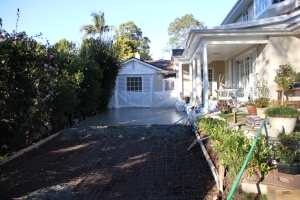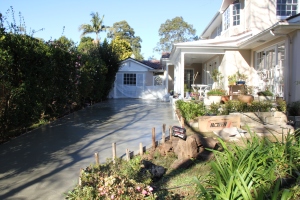With a new baby just 4 weeks away, a new driveway was a must for Al and his wife, Jackie.
While a new driveway is not typically at the top of the wish list for parents-to-be (think cots, car seats and rockers instead) this seemingly odd request actually made a lot of sense. “It’s impossible to push a stroller up a gravel driveway,” explains Al – a huge issue considering the couple’s existing gravel driveway was the main access route to the house.
Al decided a concrete driveway was the solution to this problem and listed the job on ServiceSeeking.com.au “I’d heard about the site so decided to give it a go,” he tells. Al was impressed with the great response he received, with a total of 5 businesses expressing interest in the job. A handful of these businesses then came to inspect the site to give a more accurate quotation.
After recently completing renovations and a sizeable home extension, Al is definitely no stranger to dealing with tradesmen so knew exactly what he was looking for and how much he expected to pay. “I ended up selecting Platinum Concreting Services,” he tells, expanding “they offered a mid-range quote that I thought was fair,” he tells.
However, Al didn’t hire on face value alone and did some research of his own before committing to the business. “I checked they were licensed and visited a job they were doing in Balmain to observe how they worked and check the cleanliness of the site,” he reveals. Al was impressed with what he saw so decided the proceed with the job.
Platinum Concreting Services had been registered on ServiceSeeking.com.au for just 2 weeks so owner Grant was excited to win the work. Unbelievably, the job wasn’t the first but the second one they’d been awarded through the site – amazing results for such a short amount of time. “We’ve quoted on about 15 and won 2 so far,” Grant says. You can’t complain about those odds!
While Al knew he wanted a stencilled concrete driveway he was unsure as to which pattern would best suit his home’s beautiful sandstone touches, so Grant and his team were able to make some recommendations. After they’d nutted out the finer details, Platinum Concreting Services got to work excavating the site with a bob cat, removing 10 tonnes of gravel.
We arrived on the site the following day to observe the pouring of the concrete. I was amazed to see the massive amount of work involved. A team of 4 men worked tirelessly throughout the morning, pouring and smoothing out 10 cubic metres of concrete.
Despite the physically-demanding work (although it was made to look effortless, I’m told that each pull of the roller weighed 80 kilograms) the team bought a sense of humour to the site, teasing me when I called the big mixer delivering the concrete a “vegitator.” “A vegitator? Isn’t that someone who doesn’t move off the couch,” they laughed (for the record the correct term is agitator!)
After the paper stencilling is laid, the driveway is sprinkled with sandstone colourant to help it blend with the home’s sandstone features. The next step involves literally “watching the concrete dry” – there’s nothing else to be done until the concrete reaches 12 MPa (a unit of pressure) which takes around 24 hours. The third and final day is spent saw cutting and sealing the driveway.
Al couldn’t be happier with the with his new concrete driveway – and of course ServiceSeeking.com.au for putting him in touch with Platinum Concreting Services in the first place. Not only will the driveway provide a “smooth ride” for the new baby, it looks right at home alongside his leafy North Shore residence. The new 100sqm driveway can accommodate 6-8 cars, however, Al has plans to use the extra space for his yacht which has spent years locked away in an inaccessible garage.
When asked if he has any further home improvement plans, Al says the “man can’ is next on the hit list. “Now that we’re basically finished with tradesmen traipsing around we’d like to renovate the outside toilet,” he says. And after such a positive experience, he might just post the project on ServiceSeeking.com.au!





